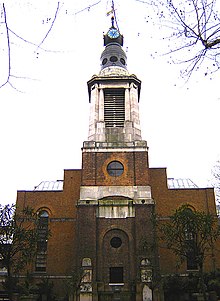St Anne's Church, Soho
| St Anne's Church, Soho | |
|---|---|

The tower and west end of St. Anne's Church, viewed from Wardour Street.
|
|
| Location | Soho, London |
| Country | United Kingdom |
| Denomination | Church of England |
| History | |
| Dedication | Saint Anne |
| Dedicated | 1686 |
| Architecture | |
| Architect(s) | William Talman and/or Christopher Wren |
| Years built | 1677–1686 |
| Administration | |
| Parish | St Anne with St Thomas and St Peter, Soho |
| Deanery | Westminster St Margaret |
| Archdeaconry | Charing Cross |
| Diocese | London |
| Province | Canterbury |
Saint Anne's Church in the Soho section of London was consecrated on 21 March 1686 by Bishop Henry Compton as the parish church of the new civil and ecclesiastical parish of St Anne, created from part of the parish of St Martin in the Fields. The Church of England parish has been the Parish of St Anne with St Thomas and St Peter since 1945. The church and parish are part of the Deanery of Westminster (St Margaret) within the Diocese of London in the Church of England. Parts of its churchyard around the tower and west end are now the public park of St Anne's Gardens, accessed from the Shaftesbury Avenue end of Wardour Street, whilst the church itself is accessed via a gate at the Shaftesbury Avenue end of Dean Street, as it does not front onto the street.
The parish was dedicated to Saint Anne because Compton had been tutor to Princess Anne before she became Queen. Construction commenced in 1677 on a plot in what was then the countryside of Soho Fields, with William Talman and/or Christopher Wren as architect(s). The church was designed as an 80 feet (24 m) long and 64 feet (20 m) wide basilican church, with a 70 feet (21 m) high west end tower.
In 1699 a tuition-free parish school was founded for boys and in 1704 it started to admit girls. The church received an organ in 1699 from the Dowager-Queen's Chapel in St James's Palace and from 1700 the church's first organist was William Croft (composer of the "St Anne" tune to O God, Our Help in Ages Past). The church's tower was only completed in 1718, with the addition of a timber spire by local carpenter John Meard. Edmund Andros was buried in the church's churchyard in 1714, in 1724/5 the church saw the marriage of Edward Harley, 3rd Earl of Oxford and Earl Mortimer, and in 1743 Prince William Henry (younger brother of George III) was baptised here.
...
Wikipedia
